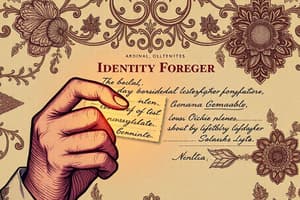Podcast
Questions and Answers
The authenticity of a digital image is determined by checking if the extracted watermark from the image matches the original watermark.
The authenticity of a digital image is determined by checking if the extracted watermark from the image matches the original watermark.
True (A)
Digital cameras can be used to record images without a watermark insertion mechanism.
Digital cameras can be used to record images without a watermark insertion mechanism.
False (B)
Watermarks can withstand image compression algorithms like JPEG.
Watermarks can withstand image compression algorithms like JPEG.
False (B)
It is possible to determine if a watermark has been inserted after image manipulation or not.
It is possible to determine if a watermark has been inserted after image manipulation or not.
The first step in the process of digital forensics is analysis.
The first step in the process of digital forensics is analysis.
Electronic devices that can be used as media in digital forensics include PCs and digital phones.
Electronic devices that can be used as media in digital forensics include PCs and digital phones.
The preservation stage in digital forensics involves reviewing the identified evidence to determine the accuracy of the results.
The preservation stage in digital forensics involves reviewing the identified evidence to determine the accuracy of the results.
The analysis stage in digital forensics involves drawing conclusions from the extracted data.
The analysis stage in digital forensics involves drawing conclusions from the extracted data.
The documentation stage in digital forensics involves identifying evidence.
The documentation stage in digital forensics involves identifying evidence.
Digital watermarking techniques are always reliable and secure.
Digital watermarking techniques are always reliable and secure.
Flashcards are hidden until you start studying
Study Notes
Image Forgery Definition
- Image forgery means manipulating a digital original image to conceal meaningful information.
- The detection of forged images is driven by the need for authenticity and to maintain the integrity of the image.
- Editing a real-world photo through computer software or mobile applications is not considered forgery, even though it has been altered from its original capture.
- Forgery can be committed for gain and prestige, creating an image to dupe the recipient into believing it is real.
Image Forgery Example
- Swapping two faces using auto face swap software is an example of image forgery.
History of Photo Manipulation
- 1860: The portrait of Abraham Lincoln is a composite of Lincoln's head and John Calhoun's body.
- 1864: A composite image of General Ulysses S. Grant in front of his troops at City Point, with the head from one picture and the horse and body from another.
- 1930: Photo manipulation has been used for various purposes.
- 1942: Benito Mussolini had the horse handler removed from the original photograph to create a more heroic portrait of himself.
- 1997: A forged image was created, with the original and forged images shown side by side.
- 2004: Another example of photo manipulation, with the original and forged images shown side by side.
- 2008: A forged image was created, with the original and forged images shown side by side.
Type of Forgery
- There are three types of forgery:
- An image created using graphical software.
- An image where the content has been altered.
- An image where the context has been altered.
Using Graphical Software
- Images can be created using graphical software, making it difficult to determine what is real and what is computer-generated.
Image Forgery Types
- The content has been altered: A forged image can be created by altering the content of its original image, duping the recipient into believing that the objects in an image are something else.
- The context has been altered: Objects can be removed or added, for example, a person can be added or removed from an image.
Digital Image Forensics
- Active techniques are based on inserting watermarks or signatures in digital images during recording.
- The authenticity is determined by checking if the extracted watermark from the image matches the original watermark.
Digital Watermark Drawbacks
- Digital cameras must be equipped with a watermark insertion mechanism during recording, which would limit this technique to be used with special cameras.
- Watermarks can be weak and may be destroyed when a watermarked image is compressed using a compressing algorithm like JPEG.
- It is not possible to decide if a watermark has been inserted after image manipulation or not.
Process of Digital Forensics
- Identification: The first step in the process, including where the evidence is found, preserved, and stored.
- Preservation: The evidence is stored in an isolated place to secure and preserve it from any tampering.
- Analysis: Reviewing the identified evidence to determine the accuracy of the results, looking for any additional data that might help answer questions about the case.
- Documentation: Drawing a series of all possible evidence of data from the given inputs.
Studying That Suits You
Use AI to generate personalized quizzes and flashcards to suit your learning preferences.




